Book contents
- Frontmatter
- Dedication
- Contents
- List of Illustrations
- List of Contributors
- List of Abbreviations
- Introduction
- I The Form and Development of West Country Houses
- II The Decoration of West Country Houses
- III The Material Culture of West Country Households
- 10 Culinary Artefacts in West Country Households, 1550–1700: Form, Function and Nomenclature
- 11 The Archaeology of the West Country Bronze Foundries
- 12 Cast Bronze Cooking Pots in England, 1500–1720
- 13 Table Glass in the West Country Home, c. 1500–1700
- 14 Portuguese Faience in South-West England
- 15 Dinner on the Ceiling: the 17th-Century Plasterwork at 144 Fore Street, Exeter
- 16 Pots and Texts: Understanding Pots in Use
- 17 Presenting an Elizabethan Interior: the Reinterpretation of St Nicholas Priory, Exeter
- Index of People and Places
- Index of Subjects
11 - The Archaeology of the West Country Bronze Foundries
from III - The Material Culture of West Country Households
Published online by Cambridge University Press: 05 May 2015
- Frontmatter
- Dedication
- Contents
- List of Illustrations
- List of Contributors
- List of Abbreviations
- Introduction
- I The Form and Development of West Country Houses
- II The Decoration of West Country Houses
- III The Material Culture of West Country Households
- 10 Culinary Artefacts in West Country Households, 1550–1700: Form, Function and Nomenclature
- 11 The Archaeology of the West Country Bronze Foundries
- 12 Cast Bronze Cooking Pots in England, 1500–1720
- 13 Table Glass in the West Country Home, c. 1500–1700
- 14 Portuguese Faience in South-West England
- 15 Dinner on the Ceiling: the 17th-Century Plasterwork at 144 Fore Street, Exeter
- 16 Pots and Texts: Understanding Pots in Use
- 17 Presenting an Elizabethan Interior: the Reinterpretation of St Nicholas Priory, Exeter
- Index of People and Places
- Index of Subjects
Summary
Five medieval and/or post-medieval bronze-founding sites were excavated in Exeter between 1971 and 2000; three further sites have been excavated elsewhere in the West Country, at Taunton (2001) and South Petherton (2004) in Somerset and Crediton in Devon (2005–7). The article discusses the evidence from these sites with the aim of providing an overview of the archaeological complexion of a typical vessel foundry, and summarizes work on the more recent sites in order briefly to report on up-to-date discoveries. It also shows something of the vessels in use and discusses the problems and uncertainties of the subject.
BACKGROUND
In the last 30 years or so the West Country has seen perhaps the greatest concentration of archaeological work on bronze vessel casting of any area in the British Isles (if not northwest Europe). During this period five foundry sites (in their broadest sense, including bell foundries) have been excavated in Exeter, with further sites elsewhere, notably at Crediton in Devon and Taunton and South Petherton in Somerset, serving to fill out the picture (Fig. 11.1). At the same time the collection of cast domestic vessels formed by Roderick and Valentine Butler and now acquired by Somerset County Museums (which delegates were privileged to see during the conference which formed the basis of this volume) has provided a significant further dimension to the study of these vessels, which were almost ubiquitous in the post-medieval household during the two centuries of concern to the conference. Much further research has gone into the industry in parallel with these endeavours, with the result that, even without excavated evidence, foundries have now been specifically located at places where they were previously unknown. This is an unusual situation in artefact studies: one in which a detailed archaeological study of a number of manufacturing sites can be matched on a large scale with a complementary collection of the products manufactured therein.
- Type
- Chapter
- Information
- West Country Households, 1500–1700 , pp. 271 - 308Publisher: Boydell & BrewerPrint publication year: 2015



